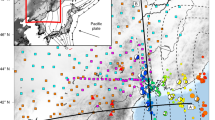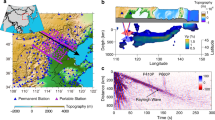Abstract
IN a letter in NATURE of November 2, p.723, it is stated by Mr. H. F. Baird, acting director of Apia Observatory, that I have found from the velocities of seismic surface waves evidence of the existence of a layer of granite some 10 km. thick below the Pacific Ocean. This statement, based on an abstract only of my paper, is liable to be quite misleading. One extract from the actual paper will make the position clear: ” Our ignorance of the structure of the Pacific floor gives no ground for applying the theory of a double surface-layer; it might be worth applying a single layer theory if we had any idea of the properties of that layer. The order of magnitude of the thickness of an equivalent single layer of granite can be found.” If that layer happens to be granite, then the theory gives 10 km. with fair accuracy; if diorite, the thickness is about 16 km.
This is a preview of subscription content, access via your institution
Access options
Subscribe to this journal
Receive 51 print issues and online access
$199.00 per year
only $3.90 per issue
Buy this article
- Purchase on SpringerLink
- Instant access to full article PDF
Prices may be subject to local taxes which are calculated during checkout
Similar content being viewed by others
Author information
Authors and Affiliations
Rights and permissions
About this article
Cite this article
STONELEY, R. Surface Structure beneath the Pacific. Nature 136, 990 (1935). https://doi.org/10.1038/136990b0
Published:
Issue date:
DOI: https://doi.org/10.1038/136990b0



